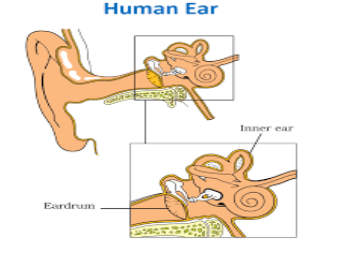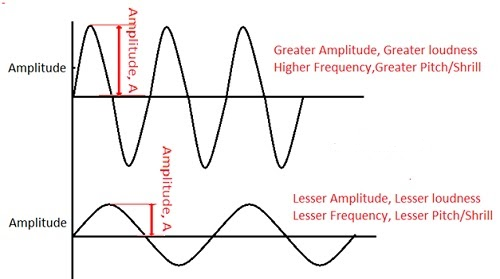SOUND for Class 8 SCIENCE
INTRODUCTION
Hamare chapter ka name hai “sound” toh sabse pehle hum janege ki sound kya hoti hai.
Sound: Yeh ek tarah ki vibrations hoti hai jo air ya kisi aur medium mein travel karti hai aur jab yeh vibrations kisi ke ears tak pahunchti hai toh hamein sound sunayi deti hai. Sound ek jagah se doosri jagah wave ki form mein travel karti hai isliye isko sound wave kaha jata hai.
Sound hamari life mein bahut important role play karti hai, yeh hamein ek doosre se communicate karne mein aur khud ko express karne mein help karti hai. Yeh sound different types ki hoti hai, eg- kuchh sounds loud hoti hai kuchh slow hoti hai, kuchh melodious hoti hai kuchh noisy hoti hai. Iss chapter mein hum padhenge sound kaise produce hoti hai, yeh kaise propagate karti hai, kiss medium mein travel karti hai, hum iss sound ko hear kaise karte hai, etc. Yaha hum sound ki characteristics aur iske factors ke baare mein bhi padhenge. Iske baad hum noise aur music mein, audible aur inaudible sound mein difference bhi samjhenge.
Sound is Produced by a Vibrating Body
Sabse pehle hum padhenge ki jo sound hum sunte hai woh kaise produce hoti hai.
Vibrating bodies sound produce karti hai aur medium ki help se sabhi direction mein sound waves travel karti hai. Lekin yeh vibration kya hoti hai?
Kisi bhi object ke back and forth ya to and fro motion ko hum vibration kehte hai. Eg- Jab hum kisi bhi tightly stretched band ko pluck karte hai toh woh vibrate karta hai aur sound produce karta hai aur jab iska vibrate hona stop ho jata hai toh yeh sound produce karni bhi stop kar deta hai.
Jab vibrating objects sound produce karte hai toh kuchh cases mein hum woh vibrations easily dekh paate hai lekin kuchh cases mein inka amplitude itna kum hota hai ki hum woh vibrations dekh hi nahi paate.
Hum apne aas-paas bahut saare musical instruments dekhte hai, unki sound sunte hai, sabhi musical instruments ke alag-alag parts vibrate karte hai. Hum niche table mein dekh sakte hai ki kounse musical instrument ka kounsa part vibrate karta hai.

Sound Produced by Humans
Humans ke throat mein voice box present hota hai jisko hum larynx kehte hai, usse sound produce hoti hai. Hum finger ko throat par rakh kar larynx ko feel bhi kar sakte hai. Voice box windpipe ka upper end hota hai, isme do vocal cords present hote hai. Yeh vocal cords iss tarah se stretched hoti hai ki inke beech mein ek narrow slit ban jati hai, jo air passage create karti hai.
Jab lungs slit mein air ko force karte hai tab vocal cords vibrate karti hai aur sound produce hoti hai. Vocal cords se kuchh muscles bhi attach hoti hai jo cords ko tight aur loose kar sakti hai. Vocal cords tight hone par different quality ki sound produce karti hai aur loose hone par different quality ki sound produce karti hai.
Mens, womens aur children mein different size ke vocal cords present hote hai. Mens mein vocal cords about 20 mm long hote hai, womens mein vocal cords 15 mm long hote hai aur children mein yeh bahut hi short hote hai.
Sound Needs a Medium for Propagation
Sound solid, liquid aur gas teeno mediums mein travel karti hai, lekin yeh vacuum (jaha koi air present nahi hoti) mein travel nahi karti. Eg- Agar hum kisi vessel mein se air ko completely remove kar de toh sound usme travel nahi kar pati.We Hear Sound through Our Ears
Hum sound ko apne ears se sun sakte hai. Ab hum ears ke structure ke baare mein padhte hai.
Ear do parts mein divided hota hai- outer ear aur inner ear. Ear ke outer part ki shape funnel ki tarah hoti hai, isme ek canal bhi present hoti hai jiske end par ek thin stretched membrane present hoti hai, isko hum eardrum kehte hai. Sound outer ear se enter karti hai aur canal mein travel karke eardrum tak pahunchti hai. Jab sound waves eardrum par padti hai toh eardrum vibrate karta hai, yeh vibrations inner ear tak jati hai, inner ear se brain tak ek signal jata hai aur hamein pata chalta hai ki hamne kya suna hai.

Amplitude, Time Period, and Frequency of a Vibration
Ab sound wave ki inn characteristics ke baare mein janne se pehle hum janege ki vibration kya hoti hai.Vibration: Kisi bhi object ka to and fro motion vibration kehlata hai. Issi motion ko hum oscillatory motion bhi kehte hai.
Kya hamne kabhi socha hai ki hum objects ko bina dekhe unki different sounds ko kaise recognise kar lete hai?
Aisa sound waves ki different frequency aur amplitude ki wajah se hota hai. Ab hum janege ki frequency aur amplitude hota kya hai.

Frequency: Ek second mein jitne number of oscillations produce hote hai usko hum frequency kehte hai. Iski SI unit hertz hoti hai jisko hum Hz se represent karte hai.
Eg- Agar koi object one minute mein 20 times oscillate karta hai toh uski frequency 20 Hz hogi.
Amplitude: Koi bhi sound wave vibrate karte time apni mean position se kitna displace hoti hai usko hum amplitude kehte hai. Amplitude ko hum (A) se denote karte hai. Kisi bhi wave ka jitna jyada amplitude hota hai woh sound utni hi loud hoti hai.
Loudness and Pitch
Loudness of sound is proportional to the square of the amplitude of the vibration producing the sound. Loudness ko hum decibel (dB) mein express karte hai.Different sources se different sounds produce hoti hai. Sound ki loudness toh amplitude par depend karti hai lekin har ek sound different hoti hai. Eg- Ek baby aur adult dono ki voice/ sound different hoti hai. Sound ke iss difference ko hum frequency se determine karte hai kyonki frequency kisi bhi sound ki shrillness ya pitch ko determine karti hai.
Kisi bhi sound ki jitni jyada frequency hogi uski utni hi high pitch hogi aur jitni less frequency hogi uski utni hi low pitch hogi.

Normally womens ki sound frequency mens ke comparatively jyada hoti hai isliye unki pitch bhi high hoti hai.
Eg- Drum jab vibrate karta hai toh uski frequency low hoti hai isliye uski pitch bhi low hoti hai. Whistle jab sound produce karti hai toh high frequency se vibrate karti hai isliye iski high pitch hoti hai.
Ab hum sounds ke types ke baare mein padhenge.
Audible and Inaudible Sounds
Sounds do tarah ki hoti hai- audible aur inaudible sounds.
Audible sounds: Aisi sounds jinko hum sun sakte hai unko audible sound kehte hai.
Inaudible sound: Aisi sounds jinko hum sun nahi sakte unko hum inaudible sound kehte hai.
Koi bhi sound audible hai ya inaudible hai woh sound wave ki frequency par depend karta hai. Human ears only 20 Hz se 20,000 Hz ki frequencies ko detect kar sakte hai isliye inke liye iss range mein aane wali sound waves hi audible hoti hai.
Noise and Music
Hum normally apne aas-paas bahut saari sounds sunte hai, usme se kuchh sounds hamein sunne mein pleasant lagti hai aur kuchh sounds hamein discomfort aur irritate karti hai.
Jo sounds hamein sunne mein pleasing lagti hai usko hum music kehte hai.
Jo sounds hamein sunne mein unpleasant aur uncomfortable lagti hai usko hum noise kehte hai.
Eg- Jab tak hum kisi bhi instrument ko normal sound mein sunte hai toh hamein woh bahut pleasing lagta hai lekin agar hum usko bahut hi loud sound mein sunege toh woh hamein unpleasing lagta hai.
Noise Pollution
Jaise ki hum jante hai ki air mein unwanted particles ka present hona air pollution kehlata hai thik waise hi environment mein excessive ya unwanted sounds ka present hona noise pollution kehlata hai.Aaj-kal vehicles, crackers, machines, loudspeakers, etc. ki sounds noise pollution ka major cause hai. Lekin agar hum television, radio, etc. ko bhi loud sound mein sunte hai toh woh bhi noise pollution create karta hai.
Ab hum noise pollution se hone wale harmful effects ke baare mein padhenge.
What are Harms of Noise Pollution?
Measures to Limit Noise Pollution
Noise pollution ko control karne ke liye hum following efforts kar sakte hai-Hearing Impairment
Jab hamein ears se sunna band ho jata hai usko hearing impairment kehte hai. Iske do reasons hote hai-
Total hearing impairment bahut kum dekhne ko milta hai lekin yeh usually by birth hota hai.
Partial hearing disability kisi injury, age ya disease ki wajah se ho sakti hai.
Aise children jinko yeh problem hoti hai unko special care ki need hoti hai. Aise bachho ko effective communication ke liye sign language sikhayi jati hai.
Jin bachho ko hearing impairment ki problem hoti hai unko defective speech ki problem bhi ho sakti hai. Lekin aaj-kal technology ki help se aise persons ki life bahut improve hui hai aur society bhi inke liye aur better environment create kar sakti hai.
POINT 1
Sound: Sound is defined as the vibrations that can travel through any medium like air and can be heard when the vibrations reach an individual or an animal’s ear.
Amplitude: It is defined as the maximum extent of vibrations produced by any vibrating body from its mean position.
Frequency: Frequency describes the number of waves that pass a fixed place in a given amount of time.
Time-period: The total time taken by the vibrating particle to complete one oscillation is known as the Time Period.
Oscillation: One completed to and fro movement of the pendulum from its mean position is known as an oscillation.
Loudness: Loudness is a sensation produced in ears which enables individuals to distinguish between a faint and loud sound.
Pitch: Pitch is a characteristic of sound which enables individuals to distinguish a soft sound and a shrill sound.
Noise: Noise is unwanted sound considered unpleasant, loud or disruptive to hearing.
Noise pollution: Noise pollution, unwanted or excessive sound that can have deleterious effects on human health, wildlife, and environmental quality.
Audible sound: The audible sounds are vibrations whose frequency lies between 20 Hz and 20,000 Hz (20 kHz).
Inaudible sound: Inaudible sounds have a frequency above 20,000 Hz or below 20 Hz.
SUMMARY
1.Sound is produced by vibrating objects.
2.In human beings, the vibration of the vocal cords produces sound.
3.Sound travels through a medium (gas, liquid or solid). It cannot travel in vacuum.
4.The eardrum senses the vibrations of sound, It sends the signals to the brain. This process is called hearing.
5.The number of oscillations or vibrations per second is called the frequency of oscillation. The frequency is expressed in hertz (Hz).
6.Larger the amplitude of vibration, the louder is the sound.
7.Higher the frequency of vibration, the higher is the pitch, and shriller is the sound.
8.Unpleasant sounds are called noise.
9.Excessive or unwanted sounds lead to noise pollution. Noise pollution may pose health problems for human beings.
10.Attempts should be made to minimise noise pollution.
11.Plantation on the roadside and elsewhere can reduce noise pollution.
